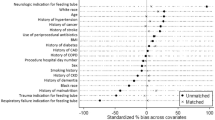Abstract
Background
Children with Pierre Robin sequence (PRS) have significant oropharyngeal abnormalities, with respiratory and feeding difficulties. Gastrostomy tubes (G-tube) provide a means for nutrition.
Objective
To evaluate the safety and efficacy of percutaneous G-tube insertion in children with PRS.
Materials and methods
Of 120 children with PRS (1996–2009), 40 were referred for G-tube insertion; clinical details were reviewed in 37/40 children (18M, 19F) at three time periods: (1) pre-G-tube insertion, (2) at G-tube insertion, (3) at G-tube removal.
Results
Pre-G-tube: 32/37 were term infants; 5 were preterm; 16/37 children were ≤ 10th weight percentile. At G-tube insertion, mean age was 66 days, mean weight 4.4 kg (1.1–7.0 kg); 19 dropped ≥10 weight percentiles; 12 tolerated nil by mouth; 2/37 were intubated for the procedure. All G-tubes were successfully placed, with five minor technical issues. Early postprocedure, there were eight minor complications and two dislodgements (classified as major). At G-tube removal mean G-tube dwell time was 2 years, with an average of 3.6 maintenance procedures per child, approximately 3 tube changes/1,000 tube days. At G-tube removal, 76% had maintained or increased weight centiles.
Conclusion
G-tubes in PRS provide a safe method for nutrition until children feed adequately by mouth.


Similar content being viewed by others
References
Robin P (1923) La chute de la base de la langue considérée comme une nouvelle cause de gans la respiration naso-pharyngienne. Bull Acad Natl Med (Paris) 89:37–41
Breugem CC, Mink van der Molen AB (2009) What is ‘Pierre Robin sequence’? J Plast Reconstr Aesthet Surg 62:1555–1558
Van den Elzen AP, Semmekrot BA, Bongers EM et al (2001) Diagnosis and treatment of the Pierre Robin sequence: results of a retrospective clinical study and review of the literature. Eur J Pediatr 160:47–53
Smith MC, Senders CW (2006) Prognosis of airway obstruction and feeding difficulty in the Robin sequence. Int J Pediatr Otorhinolaryngol 70:319–324
Evans AK, Rahbar R, Rogers GF et al (2006) Robin sequence: a retrospective review of 115 patients. Int J Pediatr Otorhinolaryngol 70:973–980
Bowling EL, Brown MD, Trundle TV (2000) The Stickler syndrome: case reports and literature review. Optometry 71:177–182
Wagener S, Rayatt SS, Tatman AJ et al (2002) Management of infants with Pierre Robin sequence. Cleft Palate Craniofac J 40:180–185
Singer L, Sidoti EJ (1992) Pediatric management of Robin sequence. Cleft Palate Craniofac J 29:220–223
Cruz MJ, Kerschner JE, Beste DJ et al (1999) Pierre Robin sequences: secondary respiratory difficulties and intrinsic feeding abnormalities. Laryngoscope 109:1632–1636
Heaf DP, Helms PJ, Dinwiddie R et al (1982) Nasopharyngeal airways in Pierre Robin syndrome. J Pediatr 100:698–703
Monasterio FO, Molina F, Berlanga F et al (2004) Swallowing disorders in Pierre Robin sequence: its correction by distraction. J Craniofac Surg 15:934–941
Sher AE, Shprintzen RJ, Thorpy MJ (1986) Endoscopic observations of obstructive sleep apnea in children with anomalous upper airways: predictive and therapeutic value. Int J Pediatr Otorhinolaryngol 11:135–146
Lidsky ME, Lander TA, Sidman JD (2008) Resolving feeding difficulties with early airway intervention in Pierre Robin sequence. Laryngoscope 118:120–123
Cooper-Brown L, Copeland S, Dailey S et al (2008) Feeding and swallowing dysfunction in genetic syndromes. Dev Disabil Res Rev 14:147–157
Denny AD, Amm CA, Schaefer RB (2004) Outcomes of tongue-lip adhesion for neonatal respiratory distress caused by Pierre Robin sequence. J Craniofac Surg 15:819–823
Bath AP, Bull PD (1997) Management of upper airway obstruction in Pierre Robin sequence. J Laryngol Otol 111:1155–1157
Gauderer M, Ponsky J, Izant RJ (1980) Gastrostomy without laparotomy: a percutaneous endoscopic technique. J Pediatr Surg 15:872–875
Preshaw R (1981) A percutaneous method for inserting a feeding gastrostomy tube. Surg Gynecol Obstet 152:658–660
Chait PG, Weinberg J, Connolly BL et al (1996) Retrograde percutaneous gastrostomy and gastrojejunostomy in 505 children: a 4 1/2-year experience. Radiology 201:691–695
Lewis EC, Connolly B, Temple M et al (2008) Growth outcomes and complications after radiologic gastrostomy in 120 children. Pediatr Radiol 38:963–970
Omary RA, Bettmann MA, Cardella JF et al (2003) Quality improvement guidelines for the reporting and archiving of interventional radiology procedures. J Vasc Interv Radiol 14:S293–295
Friedman JN, Ahmed S, Connolly B et al (2004) Complications associated with image-guided gastrostomy and gastrojejunostomy tubes in children. Pediatrics 114:458–461
Aprahamian CJ, Morgan TL, Harmon CM et al (2006) U-stitch laparoscopic gastrostomy technique has a low rate of complications and allows primary button placement: experience with 461 pediatric procedures. J Laparoendosc Adv Surg Tech A 16(6):643–649
Peters RT, Balduyck B, Nour S (2010) Gastrostomy complications in infants and children: a comparative study. Pediatr Surg Int 26:707–709
Park JH, Rhie SK, Jeong SJ (2011) Percutaneous endoscopic gastrostomy in children. Korean J Pediatr 54:17–21
Fortunato JE, Cuffari C (2011) Outcomes of percutaneous endoscopic gastrostomy in children. Curr Gastroenterol Rep 13:293–299
Wollman BS, Horacio BD, Walus-Wigle JR (1995) Radiologic, endoscopic, and surgical gastrostomy: an institutional evaluation and meta-analysis of the literature. Radiology 197:699–704
MacLean AA, Alvarez NR, Davies JD et al (2007) Complications of percutaneous endoscopic and fluoroscopic gastrostomy tube insertion procedures in 378 patients. Gastroenterol Nurs 30:337–341
Barak M, Capdevila M, Katz Y (2007) Fatal airway obstruction from percutaneous endoscopic gastrostomy in an infant with Pierre Robin sequence. Anesth Analg 105:292–293
Peters JM, Simpson P, Tolia V (1997) Experience with gastrojejunal feeding tubes in children. Am J Gastroenterol 92:476–480
Author information
Authors and Affiliations
Corresponding author
Rights and permissions
About this article
Cite this article
Al-Attar, H., Shergill, A.K., Brown, N.E. et al. Percutaneous gastrostomy tubes in children with Pierre Robin sequence: efficacy, maintenance and complications. Pediatr Radiol 42, 566–573 (2012). https://doi.org/10.1007/s00247-011-2301-2
Received:
Revised:
Accepted:
Published:
Issue Date:
DOI: https://doi.org/10.1007/s00247-011-2301-2




